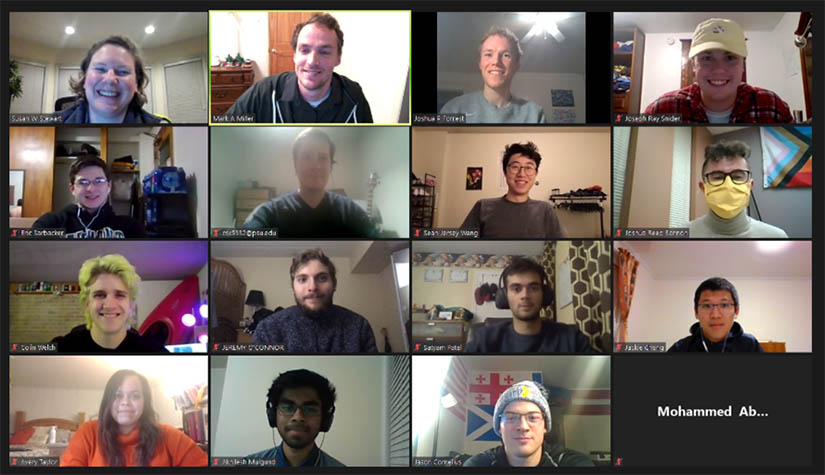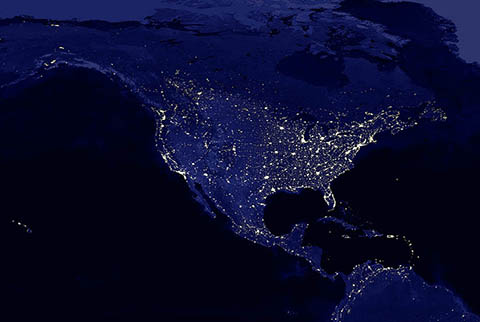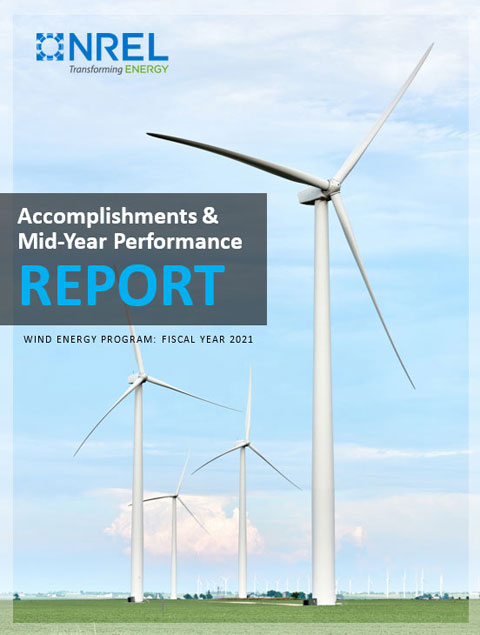The Leading Edge: July 2021 Wind Energy Newsletter
In this edition, students receive recognition for wind energy skills, and NREL researchers mark mid-year accomplishments and support a future low-carbon grid.
News Stories
Students Build Skills for the Clean Energy Economy in 2021 Collegiate Wind Competition
Following a year's worth of work and two weeks of virtual presentations showcasing their wind energy innovations, the Pennsylvania State University claimed first place overall in the U.S. Department of Energy's (DOE's) 2021 Collegiate Wind Competition. Johns Hopkins University won second place, and California Polytechnic State University won third. Students presented to a remote panel of judges June 2–10, and the competition wrapped up with a series of virtual events on June 11.
Read on to learn about the unique challenges and lessons of the 2021 Collegiate Wind Competition.

Collegiate win. The Pennsylvania State University earned the highest combined score over three contests in DOE’s 2021 Collegiate Wind Competition. The team also won the Project Development Contest. Photo from the Penn State Wind Energy Club
North American Renewable Integration Study Highlights Opportunities for a Coordinated, Continental Low-Carbon Grid
The North American Renewable Integration Study highlights challenges and opportunities for integrating large amounts of wind, solar, and hydropower across the continent to support a low-carbon future grid.
Results show that a future low-carbon North American grid can be achieved through multiple pathways that can balance supply and demand using a variety of flexible resources. The study also shows that increasing electricity trade and expanding transmission could have significant benefits, highlighting opportunities for a coordinated, low-carbon continental grid.

On the Radar

Mid-year accomplishments. NREL released a report that provides an overview of the lab’s achievements that were delivered on behalf of DOE's Wind Energy Technologies Office and other partners in the first half of Fiscal Year 2021. Photo by Josh Bauer, NREL
Program Releases Accomplishments and Mid-Year Performance Report
NREL's Wind Energy Program Accomplishments and Mid-Year Performance Report showcases research and development projects that support DOE's Wind Energy Technologies Office and its mission to reduce costs and accelerate wind technology deployment.
NREL Offshore Wind Energy Project Awarded Technology Commercialization Funding
This year, DOE funded 16 NREL awards through its Technology Commercialization Fund. Included in the full list of this year's winning projects from NREL is Offshore Wind Turbine Digital Twin for the Prediction of Component Failures, which received $200,000; Field Testing and Validation of Hybrid Optimization and Performance Platform, which received $500,000; and Open Operational Assessment, which received about $250,000.
Downwind: In Case You Missed It
Applications of Artificial Intelligence Across Wind Energy Science
The maturation of artificial intelligence (AI) and machine learning (ML) has transformed the process of data-driven science, leading to new fundamental insights and improved predictive models that can address many outstanding challenges in wind energy. In this emerging paradigm, AI/ML techniques provide a new pathway to obtaining computationally efficient surrogate models that encode the key insights from high fidelity models or experimental campaigns into design-oriented tools. In this webinar, NREL scientists highlighted several successful efforts at NREL to apply AI/ML across wind energy science.
Colorado Company Advances Its Technology To Harness Offshore Wind
The Denver Post reports that DOE awarded Denver-based company Keystone Tower Systems funding to develop equipment to manufacture spiral-welded, tapered wind turbine towers. DOE's Jocelyn Brown-Saracino says that Keystone Tower, with NREL's help, has adapted construction used by the oil and gas industry and represents an example of how the domestic supply chain for offshore wind can be developed.
Publications
Impacts of Turbine and Plant Upsizing on the Levelized Cost of Energy for Offshore Wind
Upsizing—the increase in wind turbine and power plant size—has been a major trend in offshore wind energy development. However, the quantitative impact of upsizing on project costs has not been well characterized. In Impacts of Turbine and Plant Upsizing on the Levelized Cost of Energy for Offshore Wind, NREL authors analyzed the levelized cost of energy impacts of wind turbine ratings between 6 and 20 megawatts (MW) and plant capacities between 250 and 2,500 MW for fixed-bottom offshore wind. Their results indicated that, relative to the global average turbine and plant size installed in 2019, upsizing to a 20-MW wind turbine and a 2,500-MW power plant array can reduce the levelized cost of energy by over 23%. This is primarily caused by reductions in the balance-of-system and operation and maintenance costs. These results suggest that upsizing represents a significant cost reduction opportunity for offshore wind energy and will continue to be a factor in shaping the future of the sector.
Loads Response That Is Due to Wake Steering on a Pair of Utility-Scale Wind Turbines
In Loads Response That Is Due to Wake Steering on a Pair of Utility-Scale Wind Turbines, the authors present the resulting loads of a full-scale wind turbine wake steering field campaign. Experimenting on two turbines located on a wind farm with a prevailing wind direction coming from the northwest, the authors applied wake-steering controls to an upwind turbine and instrumented a downwind turbine to measure mechanical loads. This resulted in two databases—baseline and wake-steered—with similar turbulence intensities. Comparing the two databases, the authors found minimal differences in loading but observed that the damage equivalent loads of the wake-steered case were consistently smaller than those of the baseline for most of the wind turbine components.
The Area Localized Coupled Model for Analytical Mean Flow Prediction in Arbitrary Wind Farm Geometries
In The Area Localized Coupled Model for Analytical Mean Flow Prediction in Arbitrary Wind Farm Geometries, the authors introduce the area localized coupled model. This model extends the applicability of approaches that combine classical wake superposition models and atmospheric boundary layer models to wind farms with arbitrary layouts. The authors applied the area localized coupled model to two wind farms and compared its predictions to data from two large-eddy simulations. Their findings showed that the model accurately predicted both wind farm power output and local turbine hub-height velocity for different wind farm geometries. These validations demonstrate this model's versatility when capturing results from different simulation setups and wind farm configurations. The area localized coupled model has the potential to couple large-scale atmospheric events with a controls-oriented wake model, which may impact the types of control strategies that can be deployed on a wind farm.
Share

